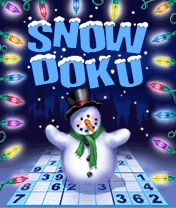
Releasing a version of a popular game is very much a double-edged sword. On the one hand, it could be classed as money for old rope, as you can practically guarantee that at least some people will buy it. On the other, it's very hard to make your product stand out in a sea of clones and rip-offs.
What you need is a hook. Something original that the other versions of the game haven't done before – that makes your product more memorable. In the case of this sudoku clone, that means adding a Christmas theme and calling it (drum roll) Snowdoku. Genius. Ahem.
To be fair, Snowdoku isn't all that bad. It gives you more than enough puzzles to occupy you on the daily commute and there are several skill levels, help modes and options to ensure that even beginners to the game don't feel left out.
Speaking of beginners, maybe now's a good time to explain the rules for the remaining few people in the world who are yet to play a game of sudoku.
When you first start a game you'll see a 9x9 lined grid that's split up into nine further squares. You'll also note that some of the spaces are filled with numbers. The basic object of the game is to work out which numbers go in the remaining spaces, bearing in mind that you can't repeat a number in a square or in a line across (or down for that matter) the whole grid.
Put like that, sudoku sounds confusing and horribly dull, but like all the most addictive puzzle games, it's quite the opposite – a game that draws you in gently before clubbing you on the back of the head with a large stick covered in addictive juice. Where once people were content to do The Times crossword on the train to work, now you see them hunched over a small book of sudoku puzzles, whimpering gently to themselves. It's like a mental Class A.
There are two types of game in Snowdoku. First, you have the basic, more traditional game, which uses numbers. Second, and this is where the name of the game comes in, you have a game where the numbers are swapped for Christmas-themed symbols – presents, holly, snowmen, and so on. The rest of the gameplay remains unchanged, only instead of filling the 3x3 grid with the numbers 1-9, you have to find a place for each of the nine presents.
It's a nice idea, but it's not really one that's needed. The basic sudoku game is good enough as it is and enjoyed the world over, and if you really need to add additional gameplay elements, it's usually a good idea to make them at least as interesting and playable as the default ones.
Matching up the symbols isn't quite so intuitive as we'd have liked, and we're obviously not alone in thinking this, as the developers have been kind enough to put a key at the top of the screen explaining what number goes with which symbol.
Snowdoku is a good enough version to be interesting for a while, but there's no end of sudoku games that don't come with novelty extras that you might try instead, such as the award-winning Platinum Sudoku.
Snowdoku Review

